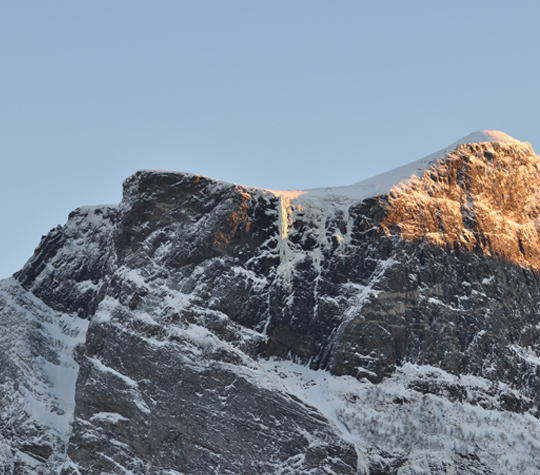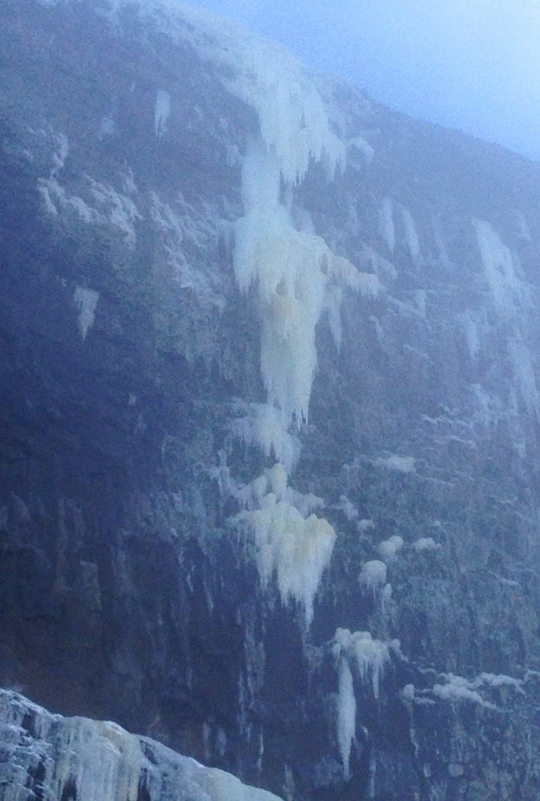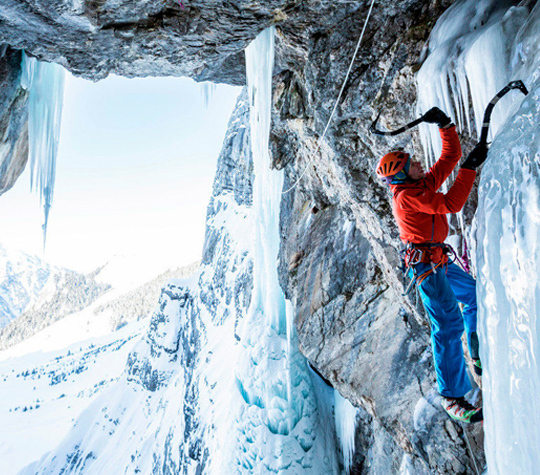Rarely have mixed climbing standards been pushed so far in a single winter. In Wyoming and Washington, Switzerland, Norway and Scotland, climbers are torquing their way up rock faces to thin ribbons of ice–or lack thereof–and they’re doing it without bolts. This has been the year of hard mixed trad climbing.
In late January, Austrian climbers Albert Leichtfried and Benedikt Purner completed Senza Piombo (WI5 M10, 5 pitches), one of the hardest naturally protected mixed climbs in the world. In early February, Aaron Mulkey led Defibrillator (M8, 40m), taking one fall and knocking off a large block in the process. In the weeks that followed, four traditionally protected mixed climbs were established.

Finnmannen (M9+ WI6+, 400m), on Senja Island in Norway, is the mixed line directly right of Finnkona (WI6), the large pure ice climb. [Photo] Ines Papert
Finnmannen (WI6+ M9+, 400m)
After spotting a climb in the background of a photo on a Norwegian lodge and guiding website, Ines Papert wrote to the owner, Bent Vidar Eilertsen, to ask if they had been climbed. He replied that only the left-most ice line had been done. She packed her bags and headed to Norway with climbing partners Thomas Senf, Nina and Christian Schlesener.
During Papert’s two-week visit to Senja, Norway’s second largest island, she roped up with Eilertsen, an internationally certified guide to climb Finnkona (WI6), just left of the potential mixed line they coveted. Finding several cracks and rock features, it seemed a direct route was possible.
Papert took the lead, laden with gear, but after 10m of climbing, the crack they thought would bring them to the ice above came to an end. Unable to protect a direct line and unwilling to use bolts, Papert traversed right and found a path through 20m of tricky climbing. Unfortunately, the two climbers ran out of gear and decided to retreat.
The following morning, equipped with even more gear, they successfully made it through the mixed pitches–but not without difficulty on the crux traverse. “Bent still had to traverse. Unfortunately he did break his blade in the first meters,” Papert says, “but I convinced him to keep going.”
It took Eilertsen two hours to get through the traverse pitch with a broken pick–yet this M9+ crux was just halfway. In an impressive 19 hour push, the pair finished Finnmannen (WI6+ M9+, 400m) by headlamp.
During the same trip, Papert and one of her German climbing partners established another hard mixed route called Aurorabuttress (M7 WI6, 4 Pitches) right behind Eilertsen’s home.
White Noise (M10+/M11, 1 Pitch) The Snotter (Scottish Grade VIII, 8)
On February 24, Dave MacLeod established White Noise (M10+/M11, 1 Pitch), a short and ice-free roof on the Cascades, Ben Nevis in Scotland. Returning from a trip to Spain and still recovering from an ankle surgery, MacLeod has been making good use of his time home in Scotland. He teamed up with Kevin Shields (who was also recovering from an ankle injury), and the two climbers opted for shorter and closer climbs above the Charles Inglis Clark Memorial Hut.
Seeing potential in an overhanging seam, MacLeod rappelled the face to take a look. “The thin seam occasionally opened enough to get the last tooth of a pick in every so often and had the occasional nut and cam slot.” MacLeod says, “It was as if it was made for ice tools.”
On his fourth attempt, MacLeod redpointed the route, completing one of the hardest single-pitch trad mix climbs in Scotland.
A few days later, MacLeod tied in with Andy Nelson to attempt an unclimbed route referred to by locals as The Snotter (Scottish Grade VIII, 8) on the Breneva Face of the Northeast Buttress, also on Ben Nevis. A drip regularly forms on the buttress but never touches down. “As far as I know, it’s never been done and has been referred to by others as ‘the last great unclimbed icefall on Ben Nevis,'” MacLeod says.
A technical groove led first to a ramp and then overhanging cracks that paved the way for the right hand icicle. “The ice ‘boomed’ a little but seemed OK,” explained MacLeod, “so I quickly swung onto it and raced for the top, stopping to de-pump halfway up so I could really enjoy the position.” As Nelson followed, a large chunk of ice broke off but the two topped out successfully after having breached difficulties estimated at VIII, 8. MacLeod describes the route as “One of the best winter climbs I’ve done on the Ben.”
Find a discussion of Scottish Winter Grades on our grade comparison page, here.
Chuck Norris and the Mortal (aka “Chucky”; WI7 M8 R/X, 90m)

Craig Pope and Jess Roskelley completed the first free ascent of Chuck Norris and the Mortal (aka “Chucky”; WI7 M8 R/X, 90m). The line was initially aided by Pope and Scott Coldiron, only days before it went free. [Photo] Jess Roskelley
Along the cliffs of Banks Lake in eastern Washington state, Craig Pope and Jess Roskelley completed the first free ascent of Chuck Norris and the Mortal (WI7 M8 R/X, 90m). The line was first aided by Pope and Scott Coldiron only days before it went free.
Pope was driving along the lake, downriver of the Grand Coulee Dam, when he spotted the line. “This year there were a lot of discontinued drips high on the walls above the lake.” Pope says, “The line was the most obvious, wild and eye-catching route…. I don’t know if it has ever previously formed.”
After a friend inspected the line from below and predicted that it wouldn’t go without bolts, Pope and Coldiron decided to accept the challenge and give it a try with gear.
The first pitch went at WI6+ M6 and was protected by a slung gas pocket and two small cams. The second pitch took a marginal 10cm ice screw and equalized 000 C3s cams and #1 Knifeblades. Coldiron followed the route on toprope only after Pope had descended–initially he was not going to follow it, but Pope had left a tool at the top.
Returning several days later, Pope partnered with Jess Roskelley, who was visiting from Alaska and was “stoked to give it a free attempt and grade confirmation.” Taking the lead, Roskelley took a 20-foot fall on the first pitch, pulling out a pin in the process. Even though the pair set a new free highpoint, they retreated in the face of rising temperatures.
Early the following morning, Pope and Roskelley returned to the climb for another attempt. They successfully freed the route by “weaving through icicles, straddling six-foot gargoyles suspended from a 120-degree rock face, and digging through an ice curtain,” Pope said. “Climbing into overhanging chandelier ice was the ride of a lifetime.”
Monty Python and the Holy Grail (WI5 M12, 165m)

Robert Jasper climbing thin ice just before reaching a tough horizontal roof on Monty Python and the Holy Grail (WI5 M12, 165m) [Photo] visualimpact.ch | Hans Hornberger
Meanwhile, in the Breitwangflue region of Switzerland, Robert Jasper was claiming the first ascent of Monty Python and the Holy Grail (WI5 M12, 165m), a line he’d seen ten years earlier while climbing the iconic Flying Circus (M10). He had even climbed the first pitch (M9), but was scared off the higher parts by loose rock and demanding climbing.
Jasper returned to the area early this winter with Markus Stofer and attempted to free the crux second pitch to no avail. He was scared off by the downward-pointing pitons and loose rock. Jasper writes that “it blocked me from moving free.”
In February, this time with Rainier Treppte as a climbing partner, Jasper climbed the M9 first pitch with confidence and use adrenaline to push through the demanding, M12 second pitch.
The remainder of the climb was still challenging. The third pitch climbing through M9 terrain and topped out with a WI5 fourth pitch. The duo completed the route as it was getting dark and named it in tribute to the (in)famous Flying Circus comedy troupe.
Monty Python and the Holy Grail was completed with a rack of cams, slings and 35 pegs and pitons that were already on the route from previous attempts.